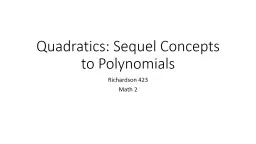PPT-Behavior of Quadratics All slides in this presentations are based on the book Functions,
Author : bery | Published Date : 2023-09-23
ISBN 9780883857670 Behavior of Polynomial Functions Behavior of Polynomial Functions depend on Degree of the polynomial most important Value of the zeros Sign of
Presentation Embed Code
Download Presentation
Download Presentation The PPT/PDF document "Behavior of Quadratics All slides in thi..." is the property of its rightful owner. Permission is granted to download and print the materials on this website for personal, non-commercial use only, and to display it on your personal computer provided you do not modify the materials and that you retain all copyright notices contained in the materials. By downloading content from our website, you accept the terms of this agreement.
Behavior of Quadratics All slides in this presentations are based on the book Functions,: Transcript
Download Rules Of Document
"Behavior of Quadratics All slides in this presentations are based on the book Functions,"The content belongs to its owner. You may download and print it for personal use, without modification, and keep all copyright notices. By downloading, you agree to these terms.
Related Documents














